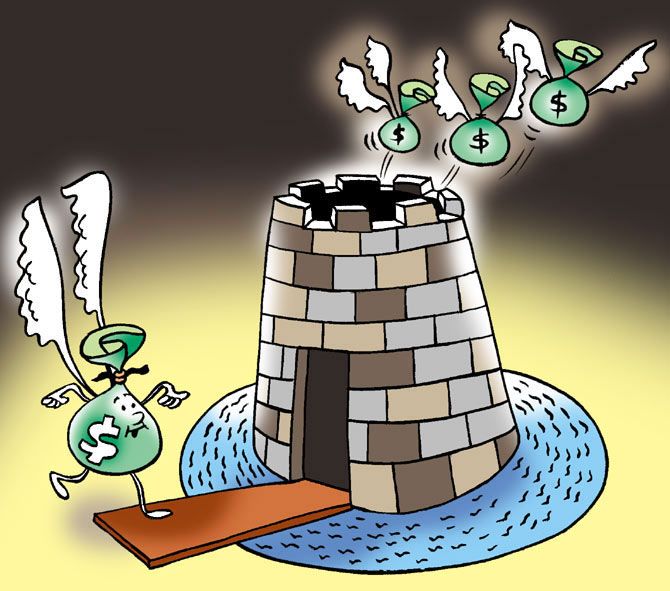If net forex outflows turn out to be relatively high in the next few years, the rupee could depreciate beyond Rs 80 to a dollar by 2022.
The causal reasons could, for example, include unmet expectations of FPI and FDI investors about the performance of the Indian economy, sharp rise in prices of imported oil and decrease in FX remittances.
The RBI has to ask itself whether guaranteeing future rupee-dollar exchange rates on FX forward contracts is a reasonable way to use its risk-bearing capacity, says Jaimini Bhagwati.
Illustration: Uttam Ghosh/Rediff.com

Indian economic growth slowed down to 5.8 per cent in the last quarter of 2018-19.
The decline in the sale of vehicles and consumer durables, and other negative indications point to a continuing slowing down of growth in the first quarter of 2019-20.
In this environment, the RBI (Reserve Bank of India) may well feel the need to do its bit to jump-start the economy by pushing up lending.
To achieve this, the RBI sought and received $ 5.02 billion from market intermediaries in exchange for Rs 34,561 crore on March 28, 2019.
The RBI accepted another $ 5 billion for Rs 34,874 crore on April 23, 2019.
The RBI’s objective was to raise the availability of rupees to address the drop in lending after IL&FS had defaulted on some of its debt.
The two dollar-rupee exchanges have been called currency swaps.
These are not standard currency swaps but spot and forward foreign exchange (FX) transactions at pre-agreed exchange rates.
Irrespective of the name given to the transactions, the RBI has stashed away around $ 10 billion and correspondingly nearly Rs 70,000 crore has been injected into the Indian financial markets.
The RBI has agreed to return the first and second tranches of the dollars it received at Rs 76.62 and Rs 78.13 to a dollar, respectively, after three years.
This is equivalent to annual depreciation of the rupee between 3 per cent and 4 per cent.
Consequently, the RBI is exposed to rupee depreciation beyond 4 per cent and the dollar providers stand to lose if the rupee depreciates less than 3 per cent per annum.
In the last three years, the nominal rupee has depreciated 0.86 per cent per annum from Rs 67.24 per dollar on July 27, 2016, to Rs 68.99 on July 23, 2019.
If India’s flawed exchange rate policies continue, those who have deposited dollars are more likely to lose as the rupee may not depreciate to Rs 76 to a dollar by 2022.
These two RBI-dollar forwards carry an assured exchange rate for the return of the hard currency and are thus different from foreign portfolio investments.
Foreign portfolio investors (FPIs) take the currency risk as they exit from their investments at prevailing exchange rates.
In the financial year 2018-19, FPI investors withdrew a net of $6 billion.
By contrast, FPIs have brought in net investments of $5 billion in 2019-20 till July 25.
About half the registered FPIs, those that are set up as trusts, may be hit by the central government’s higher tax rate on the “super-rich” in the latest Budget.
At the margin, FPIs may become net sellers.
The rupee proceeds of their sales could end up with the RBI, if foreign institutional investors (FIIs) move the equivalent foreign exchange out of the country.
Therefore, the Budget provision of higher taxes on some FPIs is inconsistent with the RBI accepting dollars to raise rupee liquidity.
According to an RBI bulletin dated July 14, 2019, the real effective exchange rate (REER) of the rupee, with 2004-05 as the base year for a basket of the six currencies, is overvalued by 24.6 per cent and against 36 currencies, the overvaluation is 18.5 per cent.
In some quarters, this overvaluation is blithely explained away as a result of higher Indian productivity.
Cross-country comparisons of productivity numbers are riddled with technical difficulties.
The more probable explanation is that in recent years, net inflows of foreign exchange (FX) on the capital account have more than met shortfalls on the current account leading to accretion of FX reserves, and thus pushing up the rupee to ridiculously high levels.
If net FX outflows turn out to be relatively high in the next few years, the rupee could depreciate beyond Rs 80 to a dollar by 2022.
The causal reasons could, for example, include unmet expectations of FPI and FDI investors about the performance of the Indian economy, sharp rise in prices of imported oil and decrease in FX remittances.
The RBI has to ask itself whether guaranteeing future rupee-dollar exchange rates on FX forward contracts is a reasonable way to use its risk-bearing capacity.
The RBI has expressed concern that banks have not stepped up lending although there is adequate rupee liquidity.
Lenders need to feel assured about the solvency of potential borrowers.
Lending decisions should be left to bank management unless we want a repeat of what happened between 2007 and 2012, when the government connived to raise public sector bank (PSB) lending, resulting in the current difficulties of the banking sector.
As of July 2019, several banks, including PSBs, are holding more government securities than required under the statutory liquidity ratio (SLR) requirement of 19 per cent of total deposits.
If banks need rupee liquidity to meet their lending requirements, they could sell some of their excess holdings of government securities.
Of course, it is the RBI’s call when to add to rupee liquidity.
Usually, central banks buy government securities through open market operations (OMOs) to increase liquidity.
If there was reluctance on the part of those who hold government securities to sell, the RBI could have found a way to buy securities issued by public sector undertakings and even highly rated private banks and corporates.
One of the alternatives for companies based in India to access borrowings from foreign creditors is through the external commercial borrowings (ECBs) window.
If the RBI wants to raise credit off-take in rupees rather than in FX, it could have temporarily lengthened the minimum permissible maturity for ECB borrowings from three to five years.
Making ECBs less easily available would have the benefit of peripherally reducing foreign currency inflows, which push up the value of the rupee.
To sum up, the RBI contracted dollar forwards to raise the availability of rupees and thus boost lending.
It follows that the RBI is confident that inflation is well under control since it added Rs 70,000 crore to rupee liquidity.
Consequently, the RBI should be in a position to reduce benchmark interest rates by, say, 50 basis points at its next rate-setting meeting.
That would be consistent with the stated reason for contracting dollar forwards.
Jaimini Bhagwati is former Government of India and World Bank professional.











